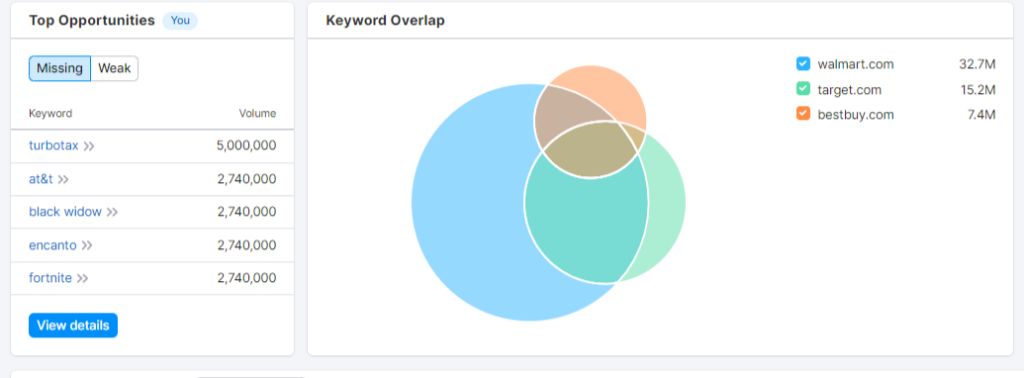Like most things in digital marketing, SEO doesn’t take place in a vacuum. As much as you may be driving your SEO efforts forward, the strategy and proactiveness of your competitors plays a large role in your success or shortfalls.
With that in mind, we include a competitor analysis in our SEO audits. Some of the items we look at are the same as the elements we look for in your environment, and some are different.
So what kind of competitive metrics can you look for in the audit?
Keyword Overlap
One of the first elements we consider is your competitors keywords they are targeting and ranking for, and how they overlap with yours. This will give you a good feel for your competitors strategy, and allow you (with our help) to tweak yours to match it where it makes sense.
That’s not to say we’ll copy their plan (although some pieces may make sense), but we’ll know what we have to do to outrank them on the topics that are important to us.
It will also show us whether or not your peers think people search the same way that you previously thought they did. In general, if there’s a lot of keyword overlap, it means the search market is well defined for your niche or vertical.
If there’s not a lot of overlap, it may mean that the way people are searching has changed, and either you or your competition have shifted their overall strategy for SEO.

GAP Analysis
Secondly, we’ll perform a GAP analysis. Here, we look for topics that your competition is generating content for where you aren’t.
These gaps may become a core part of your content marketing plan going forward, as we seek to meet your competition where they think the revenue is.
Your competition may have found success in ranking for a theme similar to their core product set, but not directly about those products. For example, if you both sell mobile phone accessories, they may actually be doing mobile PHONE reviews and ranking for them. They can then use those pages to link to relevant accessories to both sell product and boost their rankings.
If you’re not doing the same thing, we’d suggest starting to in order to “close the gap”.
Backlink Analysis
One of the core “off-page” factors in ranking well on Google is backlinks, or in other words, having many high-quality sites link to yours. This signals to Google that your site has value, and you can be rewarded for it.
If your competition has more and/or better backlinks, as well as decent content, they have a high probability of outranking you.
We’ll provide those metrics, and can show you where they are getting their links from. We can also provide you with ideas on how to get more.

Social Media Analysis
While social media profiles don’t have a direct SEO impact, they can be a signal of how well you CAN do with SEO.
Years ago, it was far simpler to have your content indexed by Google. Essentially just publishing a blog post, including it in your XML sitemap and maybe adding an internal link somewhere got the job done.
According to some research, there are 500,000 new websites launched globally… Every. Day.
You can imagine that Google, even with their seemingly infinite resources, would be hesitant to crawl and rank all those pages, if it were even possible.
So now, a better strategy is letting people find your content outside of Google, engage with it, & share it. This is a process known as “amplification”. The hope is that by having the content in front of more eyeballs will include it being in front of the “right” eyeballs. And that’s a great way to get sales and backlinks.
In that sense, your social media profile is important, and so is that of your competitors. If they are outpacing you here, as well as in SEO traffic, a specific strategy will need to be employed in order to overcome it.
Ready to Rank?
If you’re frustrated by your competition outranking you, and consequently outselling you, we’re here to help. We’ll give you an overview of why this is happening, and specific strategies and tasks you’ll need to execute on (with or without our help) in order to win.
Ready to get ranked? We’re ready to help.





